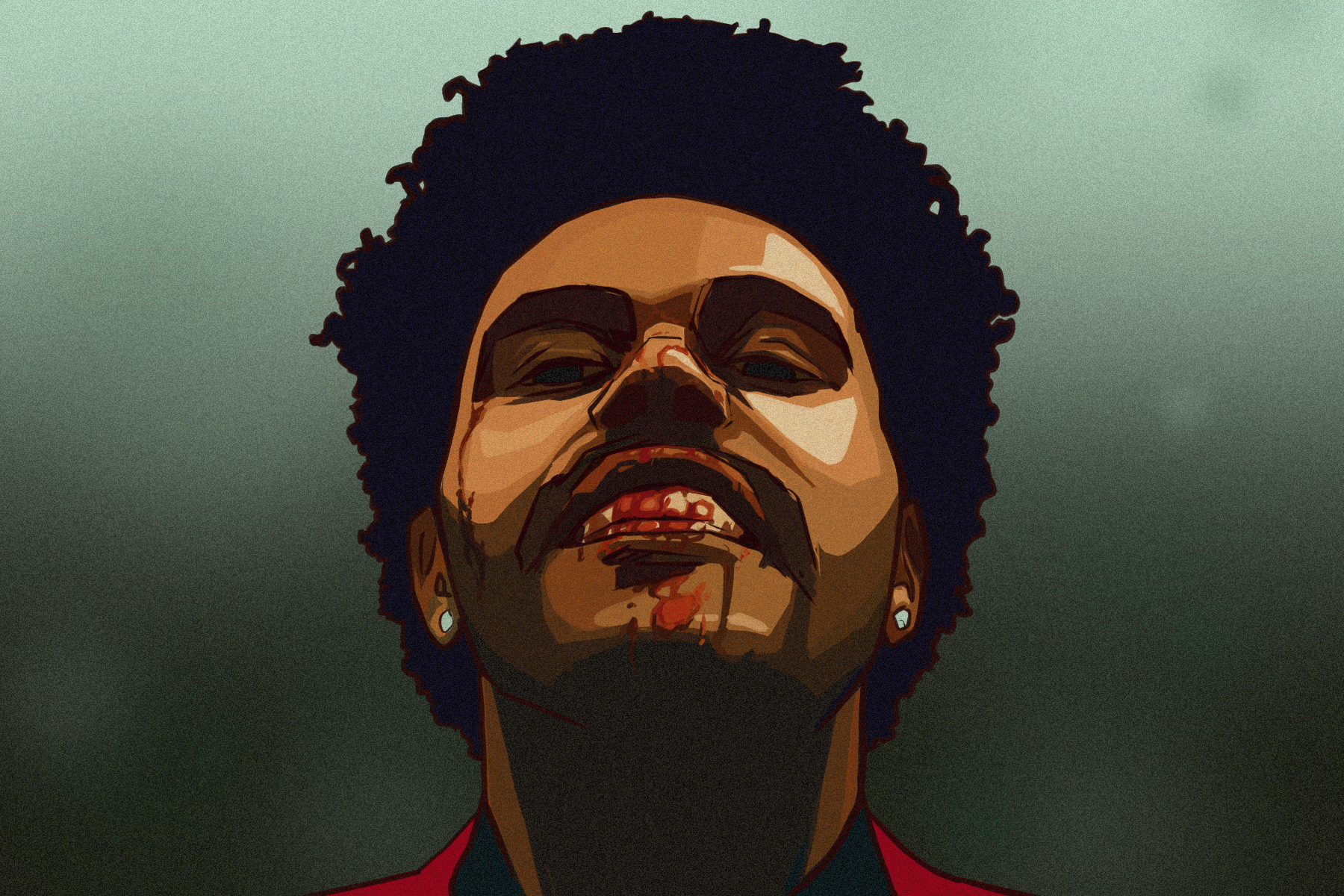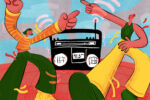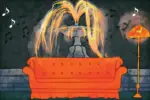Abel Tesfaye, better known as The Weeknd, grew to become one of the leading voices in music of the 2010s. His music has always been defined by a reluctance toward intimacy. It reflects many men’s hesitation about being genuinely vulnerable and how this internal struggle can manifest in toxic ways. He’s made a career putting into words the unsavory aspects of relationships that aren’t as glamorous as the love ballads many have grown accustomed to.
This theme gave his music a visceral quality, especially when accompanied by the theme of death shown in several of his music videos where he’s often violently killed. Despite his music maintaining this cold and often depressing take on intimacy, The Weeknd’s songs continued to top the pop charts. As his music evolved and career blossomed, his artistry expanded into more enormous spectacles that included elaborate performance art pieces.
Here’s how The Weeknd creatively explores the disconnect between intimacy and honesty, fame and happiness, short-lived success and inevitable death.
The Mystery
After he burst onto the scene in 2011, many were curious about The Weeknd’s dark take on the typical conventions of the R&B genre. He approached it with moral ambiguity highlighted by painfully blunt lyrics — most evident in his first notable single, “Wicked Games.” The brooding guitar strumming on the song provides a sinister undertone to a story of lust and deceit.
Rather than depicting sex as an expression of love or affection, he describes it as a deal with the devil, where he bears his vulnerabilities and indignities in exchange for a fleeting moment of empty passion. Many of his fans found this relatable because people often use physical closeness to compensate for emotional detachment — essentially, getting the satisfaction of external companionship without having to do the work of connecting on an internal emotional level.
The early portion of The Weeknd’s career seemed defined by complete cynicism. There was a certain toxicity that permeated his mixtapes (“House of Balloons,” “Thursday,” and “Echoes of Silence“) and debut album, “Kiss Land.” The Weeknd appeared to approach music from a place of self-loathing. Even when he’s been heartbroken or wronged, The Weeknd doesn’t paint himself as a sympathetic figure. Instead, he’s admittedly cruel, selfish and hurtful.
Throughout this era, The Weekend seemed ashamed of feeling close to someone, like he didn’t think he deserved to be cared for. At the same time, The Weeknd didn’t find anyone deserving of his time. For him, intimacy was never as straightforward as two people falling in love but rather an entanglement characterized by insincerity and deceit.
The Star
The Weeknd’s following album, “Beauty Behind the Madness,” saw him achieve widespread fame in the world of music. The Weeknd dropped some of the ethereal elements in favor of a more bombastic and catchy production, aided by his collaboration with Max Martin.
His most compelling single from the album was “The Hills.” He describes a secret love affair, but instead of painting it as a story of unrequited love, The Weeknd harshly maintains his distance and confirms he only cares about the sexual satisfaction his partner provides. It’s dispassionate and distasteful as he admits he only wants her for her body.
Even though the sound of his music changed, the themes didn’t. His characterization of himself as basically a scumbag made him one of the most interesting personas in music and consequently led to his newfound success as a pop singer. Suddenly, Hollywood elites were his peers, he was dating supermodels and pop singers, and his music reflected a new lifestyle.
On his next album, “Starboy,” The Weeknd had a more electronic sound that pushed his music further from the brooding aesthetic. Changing his sound and cutting his iconic hair was a move to separate himself from any specific identity he might have cultivated. The album was purposefully sporadic, representing an eclectic collage of themes, sounds and ideas.
Even as The Weeknd collaborated with Daft Punk, he was influenced by braggadocio rappers of the 2000s who all seemed to tell rags to riches stories. But notably, the album also contains surprisingly vulnerable songs that didn’t quite appear in his music before. Songs like “Die for You” and “True Colors” still come from a place of mistrust but ultimately drop the barriers The Weeknd typically placed in his music. It feels like one of the few moments he allows himself to be emotionally intimate, even as his instincts tell him not to.
That surrender of emotion led to the subsequent EP, “My Dear Melancholy.” It came to be after the dissolution of some of his real-life relationships with famous partners. In a moment of pain, he briefly returned to his old aesthetic. “Call Out My Name” has a somber beat that makes it feel like a more bitter and desperate plea to stay together. The Weeknd begrudgingly admits to being hurt despite his urge to feign indifference in the song.
It shows why he feels the impulse to distance himself from his partners. The Weeknd is afraid of developing a connection and ultimately losing it and being left to pick up the pieces in a pool of sorrow — a feeling many can relate to.
Moving forward, The Weeknd realized — while trying to rekindle the essence of who he used to be, whether he could help it or not — he’d become someone else entirely.
The Performance
After “My Dear Melancholy,” The Weekend was transitioning into a new phase of his career. His albums were growing more grandiose and conceptual, culminating in the release of “After Hours.” With the music video for the first single, “Heartless,” The Weekend debuted a noticeably different appearance, showcasing a new haircut, facial hair and a distinct red suit. It proved to be more than a one-off wardrobe choice as he donned the same look for all of his public appearances.
It slowly became clear he was performing as a character separate from himself. He put a lot of thought and detail into his public shows as he deliberately set out to make performance art spanning multiple mediums. Through music videos, short films and live performances, he weaved a loose narrative through the entire album, with tons of notable references to classic films.
Beginning with “Heartless,” our character gets lost in the glitz and glam of Las Vegas. He goes through an out-of-control night filled with partying and drugs before wandering off, seemingly trying to escape the city of sin. The story takes a turn after The Weeknd’s performance on “Jimmy Kimmel Live” as he walks away from the raucous crowd and roams around alone, faced with the emptiness he was trying to fill. Exhausted and drained, his smile fades, and his expression becomes more and more distorted, trying to express his inner turmoil.
But when he puts on the sunglasses, it’s as though he gets possessed and dragged around until we ultimately see him in a closing elevator. In this demonic state, he terrorizes a woman in a manner reminiscent of a classic slasher film until she eventually decapitates him and returns to the dance club with the severed head.
Later his head finds its way onto the street of an affluent neighborhood, where two heavily bandaged women see it. They desecrate his head before attaching it to another man’s body, apparently bringing him back to life since he later appears at the 2020 AMAs, heavily bruised, bandaged and bloody.
The story ends in regret in the videos for “Till I Bleed Out” and “Snowchild” as The Weeknd wishes he could escape the life he built — the life he dreamt of. He reminisces about all he went through — homelessness, his rise to fame — and recognizes he had little choice but to be seduced by the industry. All the fame and success took him away from poverty, but it also brought different forms of hardship to a life where he could no longer just be himself. He had to be “The Weeknd.”
Finally, in the music video “Save Your Tears,” it seems that The Weeknd is performing the song years from now in front of a small anonymous audience and barely recognizable due to botched plastic surgeries. He’s propped up on stage performing for the masked and unresponsive audience until he pulls out a gun to shoot himself — only for confetti to shower out as he smiles for the cheering crowd.
It speaks to The Weeknd’s journey with fame. The lifestyle traps him and refuses to let him go until he transforms into another soulless plastic celebrity. The end of the saga could reference Michael Jackson as he has been an inspiration and source of frequent comparison to The Weeknd his whole career.
Consider what the music industry did to Michael — milking him for decades of entertainment, ruining his life through endless paparazzi and tabloid fodder, releasing albums after his death and reanimating him for posthumous live performances; it speaks to the parasitic nature of fame. People clamor for artists to give pieces of themselves until there’s nothing left to give. Because of their similarities, The Weeknd uses his performance art to ask if he’s destined for the same tragic fate.
The album’s rollout was an extensive and ambitious endeavor, and it paid off, amassing multiple No. 1 hits, a Super Bowl halftime performance — and zero Grammy nominations. But the grand narrative and ambitious strain of performances only mask what The Weeknd expresses through the lyrics.
The performance art obscured the loneliness The Weeknd felt after finally giving himself to a relationship, only for it to crumble. The bigger story is this album. Underneath the extravagance of “After Hours,” he’s reeling from a relationship that left him broken, embarrassed and isolated.
The drugs, the parties and the excess are all distractions from his looming sense of loneliness. It reflects how he felt meeting a woman who treated him the way he’s treated women his whole life. As cataloged in his music, the nonchalant disinterested attitude he displayed toward countless women was thrown back at him, and he saw how painful it felt to be on the other side.
Dawn FM
The Weeknd’s latest project, “Dawn FM,” is another chapter in this story. He has hinted that “Dawn FM” is part of a new trilogy, although whether it is the first, second or third chapter is unknown. Still, The Weeknd created a more extraordinary interconnected story through his music. And while he seems to assume the persona of someone else through his performance art, it’s indicative of his growth into a more mature and reflective person.
Some of his longtime fans might feel like The Weeknd’s not the same sinister, shadowy artist they first discovered years ago, and he isn’t. Like his music, he’s constantly evolving and finding new and captivating ways to tell stories. No one knows whether they’re brutally honest lyrics or complex performance art. What will come after his past two projects? I encourage everyone to look forward to what The Weeknd has in store.
















